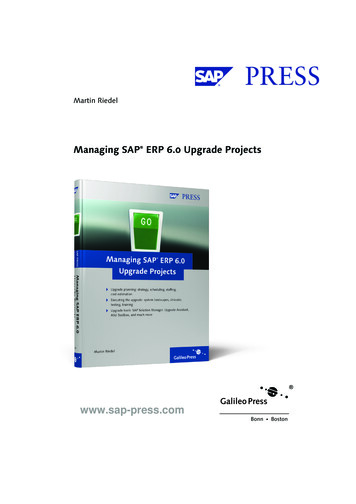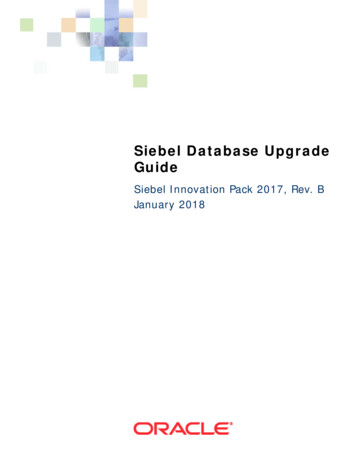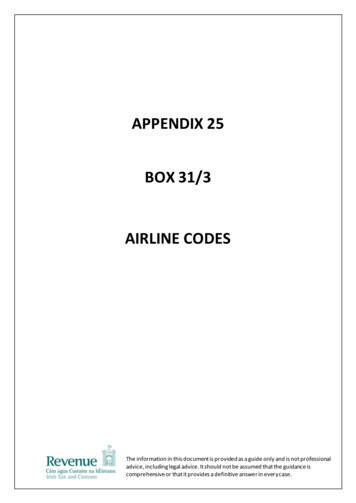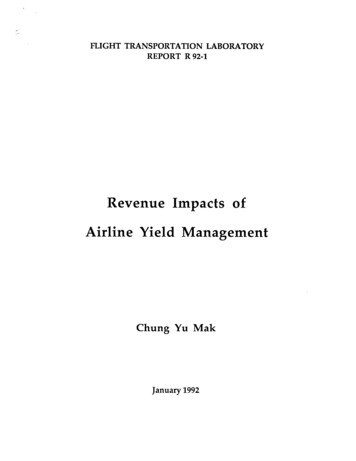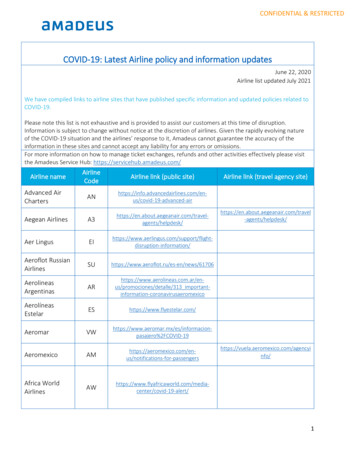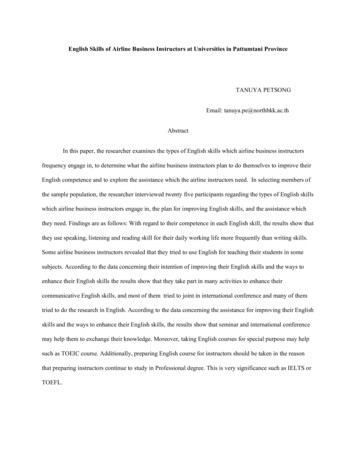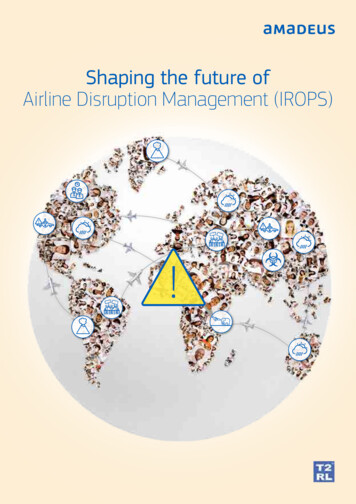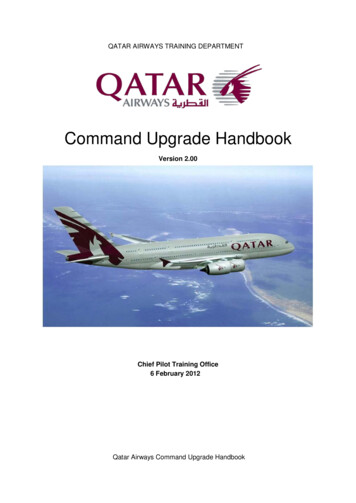
Transcription
QATAR AIRWAYS TRAINING DEPARTMENTCommand Upgrade HandbookVersion 2.00Chief Pilot Training Office6 February 2012Qatar Airways Command Upgrade Handbook
Version 2.00Training DepartmentCommand Upgrade Handbook6 February 20121INTRODUCTION TO COMMAND UPGRADE TRAINING . 52DEFINITIONS . 73CAPTAIN’S RESPONSIBILITIES . 73.13.24OPERATION MANUALS (OM) . 84.14.24.35AN INTRODUCTION . 7LEGAL STATUS . 7OM PART A: GENERAL BASICS . 8OM PART B: FCOM/QRH/MEL-CDL . 8OM PART C . 8COMMUNICATION AND DECISION MAKING . 105.1COMMUNICATION . 105.1.1 Speaking . 105.1.2 Listening . 135.1.3 Speaking Listening Communicating. 145.2COMMUNICATION & DECISION MAKING: THE VICIOUS CIRCLE. . 155.2.1 General. 155.2.2 Definitions . 165.2.3 Personalities . 166FLIGHT MANAGEMENT & FLIGHT DECK MANAGEMENT . 196.16.26.36.47FLIGHT DECK WORKLOAD MANAGEMENT . 19SOME LESSONS TO BE LEARNT: . 22TASK PRIORITISATION . 23PLANNING . 24FLIGHT PLANNING CONSIDERATIONS . 257.1WEATHER BRIEFING. . 257.1.1 Clear air turbulence. (CAT) . 257.1.2 CB’s and thunderstorm activity. 257.1.3 ‘Mechanical’ turbulence . 267.1.4 Crosswinds. . 277.1.5 Runway state . 277.1.6 Low visibility operations . 277.1.7 En - route icing forecast . 287.1.8 NOTAMs. 288DOCUMENTATION & REPORTS . 298.1REPORT WRITING . 298.2AIRCRAFT TECHNICAL LOG - CONTENTS AND REQUIREMENTS . 298.3JOURNEY LOG/VOYAGE REPORT AND COMMANDERS DISCRETION REPORT . 308.4REPORTING OF OCCURRENCES AND INCIDENTS. . 308.5CUSTOMS & HEALTH DECLARATIONS. . 318.6RECORDING OF BIRTHS, DEATHS AND MISSING PERSONS . 318.7AREA / AIRPORT FAMILIARISATION CERTIFICATE . 318.8LOAD SHEET AND NOTOC . 328.8.1 Load sheet . 328.8.2 Notification to Captain . 328.9CONCLUSION . 339FLIGHT PROCEDURES. . 349.19.2FUEL POLICY AND REQUIREMENTS . 34OFP - CHECKING . 35Command Upgrade Handbook V2.00Page 2
Version 2.00Training DepartmentCommand Upgrade Handbook6 February 20129.3EN-ROUTE ALTERNATE OR DESTINATION ALTERNATE CONSIDERATIONS . 369.4CRUISE LEVEL . 369.5ROUTING . 379.6DELAYS . 379.6.1 Pre-Start Delays . 379.6.2 En-route Delays . 389.6.3 Other considerations . 389.6.3.19.6.3.29.6.3.3Cruise Level . 38Weather . 38Operational . 399.7ALTERNATES, DIVERSIONS & TECH STOPS . 399.7.1 Take off alternate (TOFF ALTN) . 399.7.2 Destination alternate (DEST ALTN) . 399.7.3 Enroute and ETOPS alternates . 399.7.4 Company preferred alternates. 409.7.5 Technical stops . 4010EMERGENCY EQUIPMENT & SAFETY PRECAUTIONS . 4110.1PREVENTION OF HYPOXIA . 4110.1.1Introduction . 4110.1.2Physiological Considerations . 4210.1.3Breathing Air at Altitude. 4210.1.4Effects of Slow Ascent to Altitude . 4310.1.5Effects of Rapid Decompression . 4410.1.6Use of Oxygen . 4411ABNORMAL & EMERGENCY SITUATIONS . 4511.111.211.311.412DEFINITIONS. 45STUDY TOPICS . 45JUDGING AND HANDLING ABNORMAL AND EMERGENCY SITUATIONS . 46SUMMARY: . 48FAILURE MANAGEMENT . 4912.112.2GENERAL. 49MANAGING FAILURES (NOT EFATO) . 4913AIRCRAFT PERFORMANCE – REGULATIONS & OPERATING MINIMA. 5114MEDICAL . 5115DANGEROUS GOODS . 5116NEW SITUATIONS, NEW PEOPLE, NEW CHALLENGES . 5216.1FLIGHT DECK CREW . 5216.1.1First Officers . 5216.1.2Captains flying together. 5416.1.3Handing over to the next crew . 5516.2CABIN CREW . 5616.2.1Introduction . 5616.2.2Pre-flight . 5716.2.3Onboard . 5816.2.4Boarding time . 5916.2.5In Flight . 5916.2.5.116.2.5.216.2.5.316.2.5.4ETA . 59Turnarounds . 60Meal breaks . 60Unexpected turbulence . 60Command Upgrade Handbook V2.00Page 3
Version 2.00Training DepartmentCommand Upgrade Handbook16.2.5.516.2.5.66 February 2012Diversions. 61Emergency & Evacuation Procedures . 6116.2.6Post flight . 6216.3COMMUNICATIONS WITH GROUND STAFF & COMPANY . 6216.3.1Ground Staff. spatchers . 63Handling Agents . 63Operations Control Centre (OCC) . 64Flight Dispatch / Fleet Office . 65Engineering (MCC) . 65COMMUNICATIONS WITH PASSENGERS . 66NEW SITUATIONS . 6717.1PUSHBACK & STARTUP - SOME PITFALLS AND HAZARDS . 6717.2TAXIING . 6817.3HANDLING REVERSE THRUST. 6917.4REJECTED TAKE-OFF (RTO) . 7117.5DE-ICING AND ANTI-ICING . 7117.6MANAGING DELAYS . 7217.6.1Technical delays . 7217.6.2Air Traffic Control Delays . 7317.6.2.117.6.2.2Known delays . 73Advised delays . 7417.6.3Communication of delays to passengers . 7417.6.4Final. 7417.7MINIMUM EQUIPMENT LIST (M.E.L) . 7418CONCLUSION . 75Command Upgrade Handbook V2.00Page 4
Version 2.00Training DepartmentCommand Upgrade Handbook6 February 20121 Introduction to Command Upgrade TrainingThe Command Upgrade Training consists of the following: Guided self studyCommand Upgrade Course (5 Days Classroom)Command assessment flights (three)Command Selection InterviewCommand Upgrade Training (as per Part D)This manual is a self study guide. It should be used in conjunction with other studymaterial such as AOM Parts A, B, C and D etc. For brevity the male terms he/himare used throughout but are considered to be interchangeable with she/her.It is expected that all QR Captains have a good general aviation knowledge as well asgood knowledge of the company manuals and that they stay up to date with changes.It follows therefore that the same level of knowledge and commitment to learning andself improvement is expected of ‘apprentice’ captains – in other words those who haveaspirations to command. Some guidance towards areas of the manuals that haveparticularly relevance to captains is given in the section ‘The Ops manuals’.It is worth emphasising that the majority of individuals who have got into ‘bother’ ofone sort or another in the past have usually done so not because of a lack of handlingskill, but because of poor or incomplete knowledge or a failure to apply thatknowledge to best advantage.The message is clear – you must know what is in the manuals and thus be aware ofthe location of information for subsequent referral and use. You cannot be force fedthis information nor have it magically downloaded - you will have to make the effortyourself. This consists of that old fashioned concept reading! This handbook will givesome general direction to your studies and specific guidance on some other topicsthat are pertinent to an ‘apprentice captain’.Aside from widening your knowledge there will be classroom training to expand onsome aspects of commanding a modern commercial airliner. This is also youropportunity to clarify any uncertainties that you might have. Make notes of any queriesyou have and bring them to the classroom.Next comes the line flying (total of 30 sectors) to cover practical aspects of thesyllabus and look at real time operational aspects of command. First 4 sectors mustbe with a TRE, sectors number 5 to 18 can be carried with LI, TRI or TRE,whilesectors number 19 and 20 are considered as final line check and must be done with aTRE. The last 10 sectors will be done with first officers while the instructor must be aTRE who occupies the jump seat. Last 2 sectors of these 10 sectors is considered ascommand release check. The intention is to encourage your use of your new found knowledge and to involveyou in all aspects of decision making.In summary, Command Preparation is just that. It is an orientation course aimed atproviding you with an understanding of the role and responsibilities of a Captain. It isnot a Technical Refresher, a Performance Course or even a 'How to fly an Airbus orBoeing’ course. Some aspects of Technical, Performance and Handling will becovered but within the overall context of the course. You will have plenty to keep youCommand Upgrade Handbook V2.00Page 5
Version 2.00Training DepartmentCommand Upgrade Handbook6 February 2012occupied. Lastly it is not a guarantee of promotion; you have to pass the assessmentand subsequently maintain a high standard in your line operation and routine checks –just as you will when subsequently promoted.Traditionally Command Training in most airlines has been just simulator and aircraftbased. This training was primarily a 'hands on' practical experience and constitutedthe industry norm for a long time. It has become obvious that the relentless increasein the complexity and intensity of Airline operations had escalated to the point wherethis approach needed updating. The 'Command Upgrade’ course evolved as analternative.The principal aim of this was to instruct candidates in the rudiments of command andprovide a preparation process prior to evaluation.This was very successful and led to a reduction in the number of failed commandcourses. Later this was upgraded with more emphasis on improving knowledge byuse of a broad but structured syllabus, rather than just focusing on clearing the'evaluation hurdle'. The Command Upgrade course is a direct follow on from the PreCommand Training “PCT” course. Some improvements have been made in the light ofexperience, and reflect our policy towards improving qualityThe line flying evaluation will assess your decision making capabilities during 'routine'line flying, you will be expected to deal with whatever occurs on the day.The simulator evaluation will require you to demonstrate your ability to handle theaeroplane (simulator) from the LHS and to be able to take COMMAND of theaeroplane. This will include an opportunity to demonstrate your ability with failuremanagement, to prioritise your actions and those of your crew. Following on from thisyou will be debriefed and any areas requiring improvement will be commented on.Good Luck.Captain Mustafa HusseiniChief Pilot TrainingQatar AirwaysCommand Upgrade Handbook V2.00Page 6
Version 2.00Training DepartmentCommand Upgrade Handbook6 February 20122 DefinitionsThere are a number of keywords which are frequently used in Company OperationsManuals and in all relevant legislation. A review of their meaning may preventmisunderstanding.Note especially the linked words which are in bold italics.WELFARESAFETYRESPONSIBLECOMMAND CAPTAINAUTHORITYDISCIPLINEEFFICIENTLEAD Well beingFree from harm, unhurt, protected, sureAccountable, trustworthy, rationalTo order or demand with AUTHORITY, to govern or Control, toLEADthe Officer in COMMANDLegal power or rightSubjection to AUTHORITYCapable, able, effective (Efficiency Competency)Guide, conduct, persuade, direct3 Captain’s responsibilities3.1 An introductionIn the starkest terms the Captain is responsible for everything that happens on theaircraft of which he has command. It follows therefore that he must be fully aware ofhis responsibilities and those of crew and supporting ground staff. In particular hemust be aware of specific responsibilities as laid down by statute and in Companyoperations manuals and also of the wider and more general responsibility that isattached to one in a position of authority.3.2 Legal statusIn legal terms the authority of a commander is as follows:“Every person on board an aircraft shall obey all lawful commands which thecommander of that aircraft may give for the purposes of securing the safety of theaircraft and of persons or property carried therein or the safety, efficiency orregularity of air navigation.”It is a precise, unequivocal statement.The following references to the Ops Manual and other publications provide the kernelfrom which to widen the study area of command responsibilities.It must be recognised that a good Captain never ceases updating his knowledgeand appraising new information and techniques.NEVER STOP LEARNING - KEEP SHARP!Command Upgrade Handbook V2.00Page 7
Version 2.00Training DepartmentCommand Upgrade Handbook6 February 20124 Operation Manuals (OM)The importance of having a complete and up to date knowledge of Ops manualcontents has already been emphasised.You should be aware by now that the backbone of your command upgrade trainingwill be OM Part A: General Basics. As a future captain you are supposed to know allthe Operation Manuals from A to C.To aid your studies, but not to limit them, the following sections of these manualsencompass areas that are of particular significance to the Pilot in Command:4.1 OM Part A: General basicsSection 1 - (Duties and responsibilities)Section 4 Section 5 Section 6 - AllSection 7 - AllSection 8 - AllSection 9 - AllSection 10 - AllSection 11 – AllSection 12 – AllSection 14 - All4.2 OM Part B: FCOM/QRH/MEL-CDLFCOM Besides the required technical knowledge, which will be dealt withduring your simulator training, more attention should go now to theoften forgotten parts of the FCOMS. Special operations, flight planningand supplementary techniques will play a crucial role in your life asCaptain.QRH Self explanatoryMEL/CDL Make sure you know the difference in use between the MEL and CDLStudy thoroughly the MEL and make sure you are familiar with all thecodes, special authorizations and the applicability of the MEL.4.3 OM Part CCommand Upgrade Handbook V2.00Page 8
Version 2.00Training DepartmentCommand Upgrade Handbook6 February 2012Especially useful as soon as your line training will start, it is a good idea to startreading this manual (often neglected as a First Officer besides the crew layoverinformation) at this stage with “the eye of a captain”.Remember that things like the loading of the aircraft, which airport to choose in caseof a diversion and much more now becomes your direct responsibility. Goodknowledge of this manual, as well as knowing where to find what information, mightone day save your day!Command Upgrade Handbook V2.00Page 9
Version 2.00Training DepartmentCommand Upgrade Handbook6 February 20125 Communication and decision making5.1 Communication5.1.1 SpeakingCommunication in some form is a requirement of every society and it is almostuniversal that each animal species possess the ability to communicate in somerecognisable form to other members of the group and often to members of othergroups. For example, it seems now that different species of Dolphin have differentlanguages, all quite highly evolved, but there is a degree of common understandingbetween the different species. Communication is not confined to vocal means, but willin any event have a series of conventions and patterns which make it recognisableand above all repeatable.In our modern society the means of communication are developing at an amazing rateand becoming an ever more complex subject. The technology of communication is notour subject here.We will examine some rather less advanced concepts than e-mail, Internet andsatellite communications. We will consider basic communication on a person toperson level. Communication on this level is being somewhat degraded by theelectronic revolution. In our society language is the currency which enables mostcommunication. This of course is complicated on a global scale by the vast number oflanguages and dialects that exist in different ‘tribes’. They also have differentconventions on communicating. However, without language and the communicationthat it permits within its ‘subscribing’ membership there would be no exchange ofideas or information and society could not function.In our particular business we rely heavily on communication in various forms. Withoutit we, as a ‘mini-society’, could not function as we currently do.Almost everything we do involves communication of some sort; talking to ATC, read &respond checklists, P.A to the Passengers, Crew briefings, filling in the Tech. Log. orFlight Report, talking to Ops. or Crewing on the phone; all of these arecommunication. All of them contain the same elements - a sender, a message, areceiver and feedback.There are two primary mediums for communication: aural and visual. Various pathsexist for the transmission of information by both these means.However it is achieved, to be effective communication must be a two wayprocess. A verbal message is pointless if it goes unheard. If it goesunacknowledged it will be a cause for concern – Was it heard? Was itunderstood? Was it misunderstood?This is why feedback is so important. It provides a form of quality control over atransmitted message. If the message is received and understood then no fu
Command Upgrade Handbook Version 2.00. Chief Pilot Training Office 6 February 2012 . Qatar Airways Command Upgrade Handbook . Training Department Version 2.00 Command Upgrade Handbook 6 February 2012 Command Upgrade Handbook V2.00 Page 2



